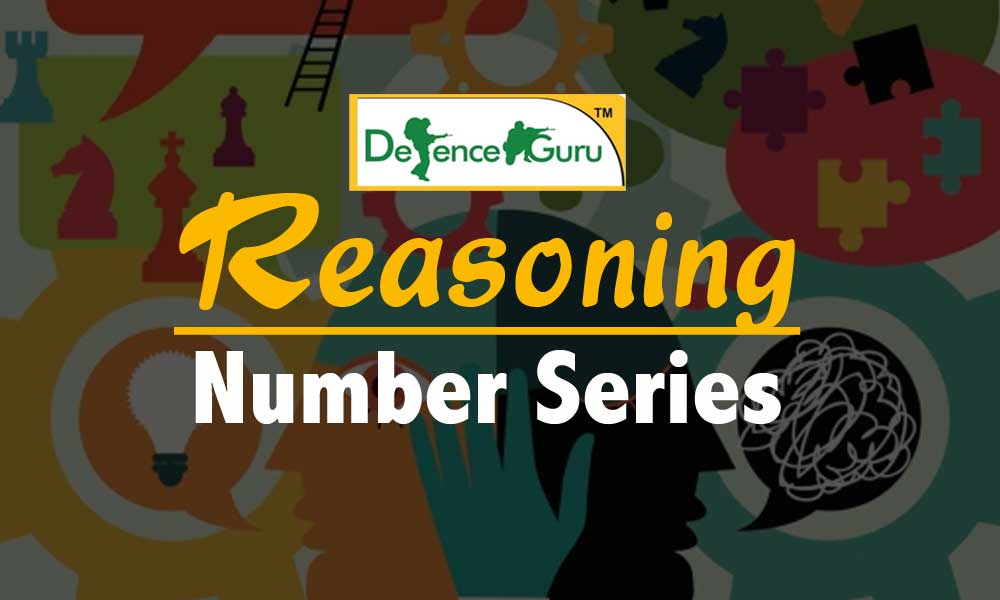Reasoning Number Series for MNS Exam
MNS (Military Nursing Service) Exam is dedicated to all those aspirants who wants to join Indian Army as a Nurse. In this post, Defence Guru provided Reasoning topics of Military Nursing Service (MNS) exam. Below we have provided some question of Reasoning Number Series for the MNS Exam conducted by Indian Army.
Reasoning: Number Series
Number series is important for various competitive examinations. In this category of questions, a series of various numbers is given with a blank . We are supposed to find out a pattern between every number and its predecessor and find out the answer using the same logic.
For the purpose of better understanding of the concept, we classify them into the following categories:
1. Series with a constant difference
2. Series with an increasing difference
3. Series with a decreasing difference
4. Squares/ Cubes series
5. Combination of different operations
6. Miscellaneous
The best approach :
The best way of approaching number series questions is to observe the difference between various terms. If we see a constant difference, then it’s a constant difference series. If the difference is decreasing or increasing by a constant number , then it is a series of type 2 or type 3. But if there is no such increase or decrease in the difference, then try dividing the 2nd term with the first, third with the second and so on. If you obtain the same number each time, then it is a product series.
Also , if none of these seem to work, then you can try writing each term as a product of two factors and try to see if there is any pattern. If you still observe no pattern and the difference is increasing or decreasing rapidly, then try to look for square/ cube series.
If the difference is increasing and decreasing in some fixed manner, then it is a type of combination series.
Let us look at each type of series in greater depth:
1. Series with a constant difference
In this kind of series, any 2 consecutive numbers have the same difference between them.
For example : 1 , 5 , 9 , 13 , ?
We can observe that we are adding 4 to the previous number to obtain the next number. So, answer here will be 13+4 = 17.
2. Series with an increasing difference
In this type of series, the difference between two consecutive terms keep on increasing as we move forward in a series. Let us try to use this theory in a question.
1,2,4,7,11,16,?
We can clearly observe that the series is increasing with the difference : +1, +2, +3 ,+4 , +5.
So, we will obtain our number by adding 6 to 16 which gives us 22.
3. Series with a decreasing difference
In this type of series, the difference between two consecutive terms keep on decreasing as we move forward in a series. Let us try to use this with some modification in the previous question that we did.
16,11,7,4,2, ?
We can clearly observe that the series is decreasing with the difference : -5, -4, -3 ,-2 .
So, we will obtain our number by subtracting 1 from 2 which gives us 1.
4. Squares/ Cubes series
We can have series where the terms are related to the squares/ cubes of numbers. We can have a lot of variations here. Let us look at some of the possibilities.
1, 9, 25, 49 , ?
We can observe that the above series is square of odd numbers starting from one. So our answer will be 9^2 = 81.
Let us look at another example:
1 , 1 , 2 , 4 , 3 , 9 , 4 , ?
We observe here that the series is formed by writing numbers starting from 1 along with its square as the next number i.e. ( 1 , 12) , (2, 22) and so on. So we obtain our answer as 16 which is 42.
Consider the following question:
9 , 28 , ? , 126.
The answer for above question will be 65, let us discuss how.
9 , 28 , ? , 126.
( 23+1) (33+1) (53+1)
The blank should have 43+1. Hence, the answer is 65.
5. Combination of different operations
This kind of series has more than 1 type of arithmetic operations which have been performed or it can also have 2 different series which have been combined to form a single series. This kind of series is the the most asked and the most important among all the types of series that we have discussed so far.
Consider the series:
1, 3 , 6 , 2 , 6 , 9 , 3 , 9 , ?
The first term 1 is multiplied by 3 to give the second term, 3 has been added to the second term to get the third term. The next term is 2 which is 1 more than the 1st term. It is multiplied with 3 to give next term and the process is continued. With this process, we obtain our answer as 12.
Consider the series:
6, 10 , 7, 11 , 8 , 12 , ?
We can see that the above series is a combination of 2 simple series:
1st , 3rd , 5th terms make an increasing series of 6 , 7 , 8….. . The 2nd , 4th and 7th term make a series of 10 , 11 , 12… . So, our answer will be 9 which is the 7th term of the original series.
6. Miscellaneous series
Some series do not come under any of the above mentioned categories but are very important and also asked in many examinations.
The series of prime numbers or any other related operation done on it comes under this category.
Consider the example:
9, 25 , 49 , 121 , ?
The above series is the squares of prime numbers. So next term will be square of 13 which is 169.
Try out the following questions:
1. 49 , 1625 , 3649 , ?
Solution : Each term in the above series is combination of squares of 2 numbers i.e.
22 32 , 42 52 , 62 72 . So, our answer will be 6481.
2. Look at this series: 40, 40, 26, 26 , 12 , ? … What number should come next?
Solution:Answer is 12. Each number is repeated or firstly 0 is added to each number and then 14 is subtracted from it.
3. 2 , 4 , 11 , 37 , ?
Solution: (2*1) + 2 =4
(4*2) + 3 = 11
(11*3) + 4 =37
(37*4) + 5 = 153
4. 6 , 3 , 3, 4.5 , 9, ?
Solution : We see that no decreasing or increasing difference logic is applicable here. So, we find out the ratios of every term with its predecessor. We get the following values: 0.5 , 1 , 1.5 , 2 . This makes it clear that 9 should be multiplied by 2.5 in order to obtain the next number.
Therefore, the answer is 9* 2.5 = 22.5 .
5. 8 , 15 , 26 , 39 , ?
Solution: Let us start by finding out the difference between every pair of consecutive terms:
15-8=7
26-15=11
39-26=13
We observe that the difference is the series of prime numbers. According to this logic , 17 should be added to 39 to obtain the answer. Hence, the answer is 56.
6. Consider the series: 42, 40, 36, 34, 30, 28, … What number should come next?
Solution: 24 is the answer . we are performing the operations : – 2, -4. )
7. 24 , 30 , 36 , 42 , 54 , 60 , 68 . Find out the wrong term in the series.
Solution: Each term is the sum of 2 consecutive prime numbers.
24 = 11+ 13
30 = 13+ 17
36= 17+ 19
So, according to this logic, 54 is the wrong term. We should have 52 in its place.
8. 17 , ? , 102 , 408 , 2040 . Find out the missing number.
Solution: We can see that the series is increasing rapidly. Let us find out the ratios of every 2 consecutive terms.
2040/ 408 = 5
408/ 102 =4
102/ ? =3
Therefore , our answer is 34.
9. 49, 47, 45 , 42 , 40 ,38 , 35, 33 ,31 , 28, ? , ?
Solution: 26 24 is the answer. It is an alternating subtraction series where 2 is subtracted twice and then 3 is subtracted one and this pattern is continued.
10. 1 , 8 , 9 , 64 , 25 , 216 , ?
Solution: The answer for this is 49. The following pattern is being followed:
12 , 23 , 32 , 43 , 52 , 63 , 72.
11. 1 , 4 , 9 , 1 , 6 , 2 , 5 , ? , ?
Solution: At a first glance it is very difficult to see any kind of pattern here. Any kind of pattern among increasing, decreasing, product , square , cube etc does not seem to be working here.
But we can observe that 1 , 4 , 9 are squares of 1 , 2 , 3 respectively. And after that should come 16 but instead of that we have 1 ,6 . After that instead of 25 , we have 2, 5. So , we can come to the conclusion that when the squares start taking 2 digits, instead of writing them as a 2 digit number , we simply separate them into 2 different terms. So, our next term will be 3 ,6 .
1. 3 2 2 5 5 5 7 8 8 9 11 11 ?
1. 12
2. 11
3. 9
4. 14
5. 16
Answer & Explanation
Sol: Option 2
Explanation: There are three parallel series going on in this question. The 1st, 4th, 7th terms are using logic of -1, 2nd, 5th and 8th terms are using logic of +1 and 3rd, 6th and 9th terms are using logic of +1 again. Answer will be 11, which belongs to 1st, 4th and 7th term.
2. 7 9 8 6 10 9 5 11 10 ? 12
1. 4
2. 11
3. 56
4. 5
5. 29
Answer & Explanation
Sol: Option 1
Explanation:There are three parallel series going on in this question. The 1st, 4th, 7th terms are using logic of -1, 2nd, 5th and 8th terms are using logic of +1 and 3rd, 6th and 9th terms are using logic of +1 again. Answer will be 4, which belongs to 1st, 4th and 7th term.
3. 1 3 2 6 3 11 4 18 5 ?
1. 27
2. 25
3. 23
4. 29
5. 20
Answer & Explanation
Sol: Option 1
Explanation:
4. 13 17 23 29 31 37 ??
1. 22
2. 41
3. 19
4. 23
5. 27
Answer & Explanation
Sol: Option 2
Explanation: The given series is a prime number series. Hence the next prime number in this sequence would be 41.
5. 17 16 14 12 11 8 8 ?
1. 4
2. 7
3. 3
4. 2
5. None of the above
Answer & Explanation
Sol: Option 1
Explanation: There are two series:
Ist : 17 14 11 8 and 2nd: 16 12 8 ?
In first series, -3 , -3 ,-3….. and in 2nd series , -4 , -4 ,-4….
Therefore, next term will be 8 – 4 = 4.
Directions for questions 6-10: In each of the following number series only one number is wrong. Find out the wrong number.
6. 3, 12, 8, 19, 13, 32, 18, 42, 23, 52
1. 12
2. 19
3. 42
4. 32
5. None of the above
Answer & Explanation
Sol: Option 2
Explanation: The sequence is a combination of following two series:
I. 3, 8, 13, 18, 23 and II. 12, 19, 32, 42, 52
The pattern in I has a constant difference of +5, and the pattern in II has a constant difference of +10. So, in II, 19 is wrong and should be replaced by (12+10) i.e. 22
7. 31, 2, 41, 3, 52, 4, 61, 5, 71, 6
1. 41
2. 61
3. 52
4. 31
5. 6
Answer & Explanation
Sol: Option 3
Explanation: The sequence is a combination of two given series:
I. 31, 41, 52, 61, 71 and II. 2, 3, 4, 5, 6
So, the pattern in I is + 10
Thus, 52 is wrong and should be replaced by (41 + 10) i.e. 51.
8. 10, 5, 19, 12, 39, 26, 73, 54
1. 5
2. 19
3. 39
4. 26
5. 54
Answer & Explanation
Sol: Option 3
Explanation: The sequence is a combination of the following two series:
I. 10, 19, 39, 73, and II. 5, 12, 26, 54
The pattern in I becomes + 9, + 18, + 36, So 39 should be replaced by 37. So, 39 is wrong.
9. 1, 10, 9, 16, 25, 26, 49
1. 1
2. 16
3. 26
4. 9
5. 49
Answer & Explanation
Sol: Option 2
Explanation: The given sequence is a combination of two series:
I. 1, 9, 25, 49 and II. 10, 16, 26
The pattern in I is +8, +16, +24.
The sequence in II is 32 + 1, 42 + 1, 52 + 1
So, 16 is wrong and must be replaced by (42 + 1) i.e. 17.
10. 1, 125, 729, 2177
1. 2177
2. 729
3. 125
4. 1
5. 121
Answer & Explanation
Sol: Option 1
Explanation: 1, 125, 729, 2177
1 = 13 , 125 = 53, 729 = 93. So, next number would be 133= 2197
Therefore, 2177 is wrong.






